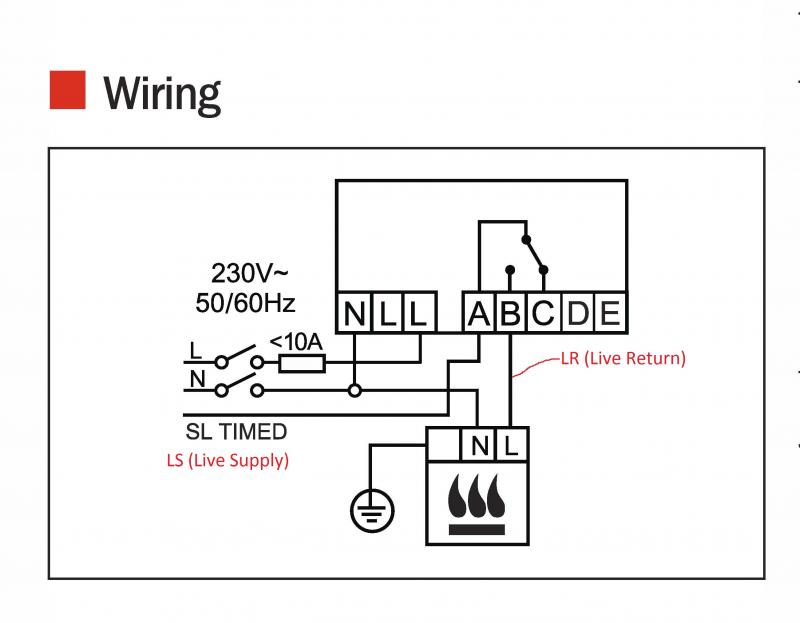Hello folks, nice to find a forum with some activity on it!
I've recently wired the DT92e base to my system for wireless control as such:-
Boiler shows Lr Ls Ns - N L Eth for stat connection of which the N and L are supplying the boiler with power.
The Dt92e base shows connections of N L L - A B C
After finding wiring advice on a few sites, I've wired it:-
Boiler - Stat
Ns - N
Ls - L (1st L)
Lr - B (open switch symbl)
Then made connecting links on the stat base from L1 to L2, then L2 to A
Everything seems to be working fine. The wireless stat only fires the boiler when it is in timed mode or on permanently which is good, and if I reduce the stat temp dramatically, the boiler stays off until the room finds the level again then goes through its heating cycles to maintain the new temp. So all looks ok.
(I think the whole point of listing my connections is for reassurance more than anything! ) I'm sure something is slightly wrong....
) I'm sure something is slightly wrong....
My main question is the settings.
Am i right in seeing that the boiler should always be set at maximum for the heating, and the rad TRV set to max in the room with stat? If so, is this to reach the stat temp as soon as possible to switch it off quicker?
As a result I'm finding the other radiators glowing hot and the boiler running at 30'C in order to achieve a room temp of 21'C, which is making the house unbearable. (The stat is head height so reading in the right area). Even some TRV's are set to 4 but the rads are blistering hot!!!
If I set my boiler slightly lower, it runs cooler but then takes longer to get to the stats temperature in that room, and the other rads are still glowing.
So what's the general concensus regarding controls?
Turn the boiler down slightly and let it take longer to reach room temp at the stat, or boiler full belt to reach temp quicker, and make sure the TRV's on all radiators are working properly?
I'm going to replace my TRV's on some rads because I think they could be faulty but will check the pins are still moving.
Thanks for your patience reading this lot guys....
Have I wired it right, and what settings do others recommend?
Any advice or opinions welcome.
Cheers, Eddie.
I've recently wired the DT92e base to my system for wireless control as such:-
Boiler shows Lr Ls Ns - N L Eth for stat connection of which the N and L are supplying the boiler with power.
The Dt92e base shows connections of N L L - A B C
After finding wiring advice on a few sites, I've wired it:-
Boiler - Stat
Ns - N
Ls - L (1st L)
Lr - B (open switch symbl)
Then made connecting links on the stat base from L1 to L2, then L2 to A
Everything seems to be working fine. The wireless stat only fires the boiler when it is in timed mode or on permanently which is good, and if I reduce the stat temp dramatically, the boiler stays off until the room finds the level again then goes through its heating cycles to maintain the new temp. So all looks ok.
(I think the whole point of listing my connections is for reassurance more than anything!
My main question is the settings.
Am i right in seeing that the boiler should always be set at maximum for the heating, and the rad TRV set to max in the room with stat? If so, is this to reach the stat temp as soon as possible to switch it off quicker?
As a result I'm finding the other radiators glowing hot and the boiler running at 30'C in order to achieve a room temp of 21'C, which is making the house unbearable. (The stat is head height so reading in the right area). Even some TRV's are set to 4 but the rads are blistering hot!!!
If I set my boiler slightly lower, it runs cooler but then takes longer to get to the stats temperature in that room, and the other rads are still glowing.
So what's the general concensus regarding controls?
Turn the boiler down slightly and let it take longer to reach room temp at the stat, or boiler full belt to reach temp quicker, and make sure the TRV's on all radiators are working properly?
I'm going to replace my TRV's on some rads because I think they could be faulty but will check the pins are still moving.
Thanks for your patience reading this lot guys....
Have I wired it right, and what settings do others recommend?
Any advice or opinions welcome.
Cheers, Eddie.


